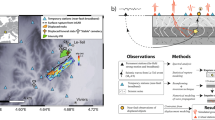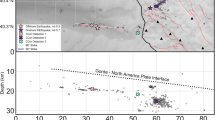Abstract
IN August 1962 the United Kingdom Atomic Energy Authority put into operation a Geneva-type seismic station at Eskdalemuir. Full details of the station design and operation are given by Truscott1; but briefly it consists of two mutually perpendicular lines of seismometers, each line being just under 9 km long, and containing 11 equi-spaced short-period seismometers.
This is a preview of subscription content, access via your institution
Access options
Subscribe to this journal
Receive 51 print issues and online access
$199.00 per year
only $3.90 per issue
Buy this article
- Purchase on Springer Link
- Instant access to full article PDF
Prices may be subject to local taxes which are calculated during checkout
Similar content being viewed by others
References
Truscott, J. R., The Eskdalemuir Seismological Station, (to be published).
Thirlaway, H. I. S., New Sci., 18, 338, 311 (1963).
Author information
Authors and Affiliations
Rights and permissions
About this article
Cite this article
KEY, F., MARSHALL, P. & MCDOWALL, A. Two Recent British Earthquakes recorded at the U.K. Atomic Energy Authority Seismometer Array at Eskdalemuir. Nature 201, 484–485 (1964). https://doi.org/10.1038/201484a0
Issue Date:
DOI: https://doi.org/10.1038/201484a0
This article is cited by
-
Epicentre Determination by Seismic Arrays
Nature (1968)
Comments
By submitting a comment you agree to abide by our Terms and Community Guidelines. If you find something abusive or that does not comply with our terms or guidelines please flag it as inappropriate.



